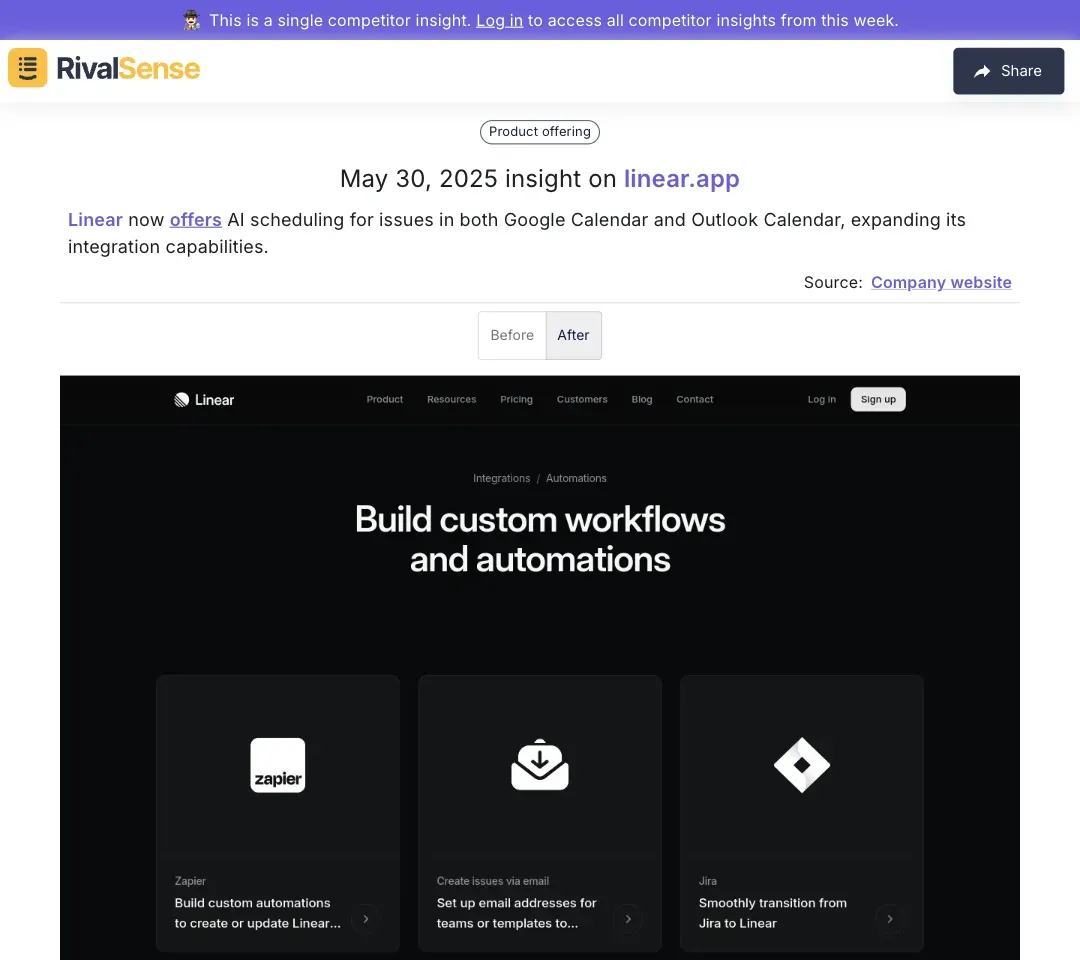How Linear's AI Scheduling Spurred Competitor Innovation
The integration of Artificial Intelligence (AI) into business tools has transitioned from a luxury to a necessity, revolutionizing how companies operate and compete. Among the myriad of applications, AI-driven scheduling tools stand out for their ability to streamline workflows, reduce manual errors, and enhance productivity. Linear, a prominent player in the project management space, recently made waves with its AI scheduling feature, setting a new benchmark for efficiency.
This innovation not only elevated Linear's market position but also sent ripples across the industry, prompting competitors to rethink their strategies. By analyzing rival responses, we uncover actionable insights into competitive intelligence and market adaptation—essential knowledge for founders, CEOs, and business leaders navigating rapid industry evolution.
Practical Takeaways:
- 🔍 Monitor Competitor Moves: Track key players to identify emerging trends
- 📊 Assess Market Impact: Evaluate how new features shift user expectations
- 💡 Innovate Proactively: Turn competitor ideas into unique solutions
- 🗣️ Engage Your Audience: Use feedback to refine offerings
Linear's AI Scheduling: A Game-Changer ⚡
Linear's AI scheduling feature has redefined productivity tools by automating task prioritization and deadline management with unprecedented precision. At its core, the feature leverages machine learning to analyze project timelines, team workloads, and performance metrics to suggest optimal schedules. Key benefits include:
- ⏱️ 30% reduction in project delays (reported by early adopters)
- 🔄 Dynamic real-time adjustments
- 🧠 Personalized task sequencing aligned with peak productivity hours
Unique selling points are its seamless integration with existing workflows and adaptive learning capabilities. The overwhelmingly positive reception highlighted its role in mitigating burnout through balanced workload distribution—a common pain point in project management.
Practical Implementation Checklist:
- ✅ Audit your team's scheduling pain points
- ✅ Run pilot tests for workflow compatibility
- ✅ Collect feedback to refine AI customization
- ✅ Track metrics like project completion times
Competitor Landscape Before Linear's Innovation 🕰️
Prior to Linear's AI scheduling release, the market was dominated by tools like Calendly and Microsoft Bookings that offered basic functionalities but lacked predictive capabilities. These solutions struggled with dynamic team schedules, time zone complexities, and priority-based arrangements, creating clear gaps for innovation.
User frustrations around manual inputs and inefficient multi-participant scenarios left the industry ripe for disruption. This environment allowed Linear to differentiate itself by addressing unmet needs with its AI-driven, learning-based approach.
Actionable Gap Analysis Framework:
| Step | Action |
|---|---|
| 1. Audit | Compare competitor feature sets |
| 2. Analyze | Mine user reviews for recurring complaints |
| 3. Anticipate | Monitor emerging tech competitors ignore |
Competitor Reactions and Strategic Moves ♟️
Linear's update triggered immediate strategic shifts across the industry. Competitors like Asana and ClickUp rolled out AI features within weeks, while others pursued acquisitions of AI startups to accelerate capabilities. These responses revealed a critical lesson: real-time awareness of competitor updates is strategic oxygen.
Consider how tracking product launches delivers value: Knowing about integrations like Linear's expansion into Google Calendar and Outlook Calendar helps you benchmark offerings and spot innovation opportunities. For example:
RivalSense Insight: Linear now offers AI scheduling for issues in both Google Calendar and Outlook Calendar, expanding its integration capabilities.
Why this matters: Such insights reveal strategic positioning shifts before they impact market share.
Competitor Response Checklist:
- 📍 Track feature updates and unique angles
- ⏱️ Analyze rollout timing strategies
- 🤝 Monitor partnerships/acquisitions
- 🗣️ Assess customer feedback on new features
- 🗺️ Align findings with your product roadmap
Impact on Market Dynamics and User Preferences 📈
Linear's move permanently altered user expectations, with demand now centered on predictive scheduling, minimal manual input, and seamless integrations. Competitors observed measurable market share shifts toward platforms offering similar AI efficiencies, proving that innovation isn't optional—it's existential.
The long-term implications point toward AI-powered tool consolidation, pushing out slow adopters. Businesses must now proactively invest in AI capabilities while maintaining rigorous competitor monitoring to anticipate trends rather than react to them.
Adaptation Framework:
- 🔍 Continuously benchmark against user expectations
- 🤖 Identify AI feature gaps in your offerings
- 🚀 Develop phased implementation timelines
Conclusion: Lessons Learned and Future Outlook 🔮
Linear's case demonstrates that AI-driven innovation serves as both efficiency booster and market differentiator. The key takeaway for business leaders is twofold: cultivate internal innovation cultures while maintaining vigilant competitor awareness. As scheduling tools evolve toward predictive analytics and automated decision-making, agility becomes the ultimate competitive advantage.
Sustained Innovation Checklist:
- 🔄 Quarterly competitor innovation reviews
- 🎓 Ongoing team tech training
- 📣 Customer feedback integration loops
Ready to decode competitor moves like product launches, pricing shifts, and partnerships? Try RivalSense free to receive your first automated competitor report today: https://rivalsense.co/. Our platform tracks updates across websites, social media, and registries—delivering actionable intelligence in weekly digest emails.
📚 Read more
👉 Unlock Competitor Secrets: A Founder's Guide to LinkedIn Benchmarking
👉 Unlocking Competitive Edge: Analyzing Competitor Partnerships & Client Wins
👉 4 AI-Driven Strategies for Competitive Intelligence in Healthcare
👉 AKASA vs. Competitors: AI in Healthcare Revenue Cycle Analysis
👉 Competitor Tracking on Autopilot: How RivalSense Delivers Effortless Competitive Intelligence

